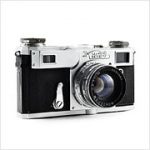Zeiss Ikon Ikonette (500/24) Specifications
| Manufacturer: | Zeiss Ikon AG |
| Origin: | West Germany |
| (modern day Germany) | |
| Made in: | Stuttgart, West Germany |
| (modern day Germany) | |
| Introduced: | 1958 |
| Type: | Viewfinder |
| Format: | 135 Film |
| Dimensions: | 13.1 x 7.6 x 6.9 cm |
Zeiss Ikon Ikonette (500/24) Overview
The Zeiss Ikon Ikonette (500/24) is an unusual, kidney-shaped 35mm viewfinder camera introduced in 1958 by Zeiss Ikon (not to be confused with Zeiss Ikon’s Ikonette (504/12) folding camera from 1929). Unlike anything Zeiss Ikon had produced either before or since, the plastic Ikonette’s primary selling points were its simplicity, price, and looks. It was also, as far as I can tell, the only Zeiss Ikon camera that was ever marketed specifically towards women, stating that their eyes will “light up” as the camera “instantly appeals to the feminine sense of beauty” and that “it’s so easy to operate, she’ll get fine pictures right from the start.”
In the spirit of keeping things simple, nearly all the Ikonette’s controls are attached to the 45mm f/3.5 Novar-Anastigmat lens. The enormous plastic lever (which is referred to by Zeiss Ikon as the “rapid sequence lever”) at 10:30 on the lens barrel (perhaps the most eye-catching component) functions as the shutter button as well as the shutter cocking mechanism: the first action trips the shutter, then a second, longer action resets the camera for the next exposure. When the shutter is fired, a red flag appears in the optical viewfinder until the shutter is cocked. A tiny red-tipped lever at eight o’clock triggers a self-timer and a flash sync socket is located at five. Aperture selections are made by rotating ring closest to the body of the camera via the dark blue plastic tab. A curved cutout at 12:00 will show you which f-stop you’ve chosen. Shutter speeds are set by rotating the large silver ring and focusing is done by rotating the smaller silver ring immediately surrounding the lens’ front element.
The top plate houses a threaded shutter cable socket, a cold shoe with spring-loaded cover, and the frame counter. The film rewind release is found on the back of the camera just underneath the frame counter. By holding this release open, the user can then rewind the film back into the cassette via the knob on the left side. The latch that releases the back of the camera and a standard tripod socket are located on the bottom plate.
While it’s true that the Ikonette’s curious design, simplified controls, and low price point are completely uncharacteristic of Zeiss Ikon, perhaps the most surprising aspect of this camera is its quality. In a word, the Ikonette is disappointing. The plastic body panels are easily scratched, the “rapid sequence lever” almost feels like it’s going to break off in your hand when you cock the shutter, and then there’s the fitment. I have two Ikonettes in my collection and the back of one comes off much too easily while the back of the other is almost comically difficult to remove and replace. The shutter of one of my Ikonettes is also broken which, as I understand it, is a common issue. On top of all that, the Ikonette suffered so severely from light leaks that Zeiss Ikon scrambled to recall as many of these cameras as possible and had them all unceremoniously destroyed.
Despite all its shortcomings, I rather like the Ikonette. If you evaluate it objectively as a camera, it’s quite poor but if you look at it as Zeiss Ikon’s moment of lunacy and consider that its failings snapped the company into damage control mode, it’s got a good amount of historic value.
Find your very own Zeiss Ikon Ikonette (500/24) on eBay.
McKeown, James M. and Joan C. McKeown’s Price Guide to Antique and Classic Cameras, 2001-2002. (Grantsburg, WI, USA: Centennial Photo Service, 2001), p 721.


















